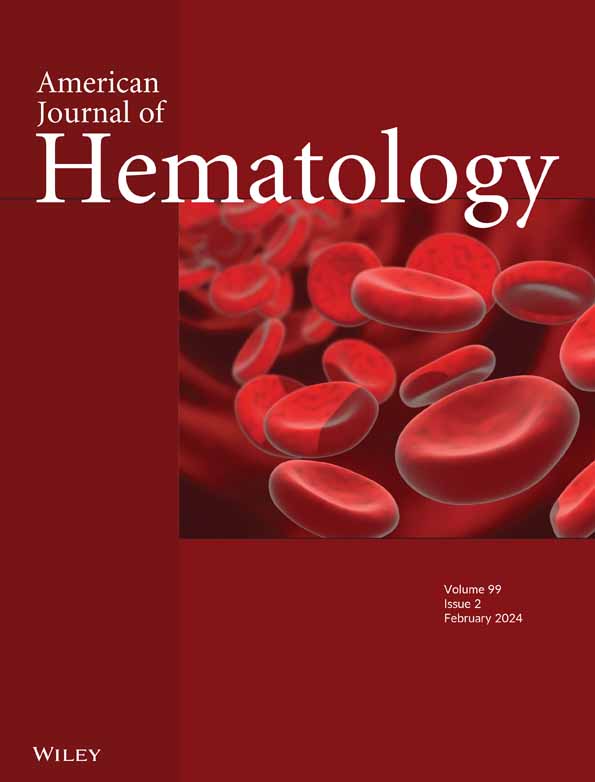Hemochromatosis Proteins Hemojuvelin and Homeostatic Iron Regulator in Bone Morphogenetic Protein‐Mediated Hepcidin Regulation and Iron Homeostasis
IF 9.9
1区 医学
Q1 HEMATOLOGY
引用次数: 0
Abstract
The bone morphogenetic protein (BMP)‐SMAD signaling pathway is central to regulating hepcidin, the master regulator of systemic iron homeostasis. We have previously demonstrated that BMP6, BMP2, and, to a lesser extent, BMP5 are the major ligands contributing to hepcidin and iron homeostasis regulation in vivo. Hemojuvelin (HJV) and homeostatic iron regulator (HFE) are hepcidin modulators that are mutated in hereditary hemochromatosis. Although both HJV and HFE regulate hepcidin, at least partly, by functionally interacting with the BMP–SMAD pathway, the mechanisms are incompletely understood. Notably, both HJV and HFE can regulate hepcidin in a BMP6‐independent manner. To understand whether HJV and HFE influence hepcidin regulation by BMP2 and/or BMP5, we investigated the iron phenotype of mice with combined mutations in endothelial血色素沉着蛋白:骨形态发生蛋白介导的Hepcidin调节和铁稳态
骨形态发生蛋白(BMP) - SMAD信号通路是调节hepcidin的核心,hepcidin是系统铁稳态的主要调节因子。我们之前已经证明,BMP6、BMP2和BMP5(在较小程度上)是体内hepcidin和铁稳态调节的主要配体。血红蛋白(HJV)和稳态铁调节剂(HFE)是遗传性血色素沉着症中发生突变的hepcidin调节剂。尽管HJV和HFE都通过与BMP-SMAD通路的功能相互作用来调节hepcidin,但其机制尚不完全清楚。值得注意的是,HJV和HFE都可以以不依赖于BMP6的方式调节hepcidin。为了了解HJV和HFE是否会影响BMP2和/或BMP5对hepcidin的调节,我们研究了内皮细胞BMP2 / HJV和BMP5 / HFE联合突变小鼠的铁表型。我们发现内皮细胞Bmp2/Hjv双敲除(KO)小鼠比单内皮细胞Bmp2或Hjv KO小鼠表现出更严重的hepcidin缺乏和铁超载,类似于先前在双内皮细胞Bmp2/Hfe KO和Bmp6/Hjv KO小鼠中的发现,或者Bmp6和Hfe的功能丧失。此外,我们发现铁在内皮细胞Bmp2/Hjv和Bmp2/Hfe双KO小鼠中完全不能诱导hepcidin。相反,BMP5的功能丧失不会加重Hfe KO小鼠的血色素沉着病。结合其他已发表的数据,这些发现提示了一个模型,其中BMP2和BMP6可以独立于HJV和HFE诱导hepcidin,反之亦然。相反,在缺乏BMP2和BMP6的情况下,BMP5、HJV和HFE都是铁介导的hepcidin调节所必需的。
本文章由计算机程序翻译,如有差异,请以英文原文为准。
求助全文
约1分钟内获得全文
求助全文
来源期刊
CiteScore
15.70
自引率
3.90%
发文量
363
审稿时长
3-6 weeks
期刊介绍:
The American Journal of Hematology offers extensive coverage of experimental and clinical aspects of blood diseases in humans and animal models. The journal publishes original contributions in both non-malignant and malignant hematological diseases, encompassing clinical and basic studies in areas such as hemostasis, thrombosis, immunology, blood banking, and stem cell biology. Clinical translational reports highlighting innovative therapeutic approaches for the diagnosis and treatment of hematological diseases are actively encouraged.The American Journal of Hematology features regular original laboratory and clinical research articles, brief research reports, critical reviews, images in hematology, as well as letters and correspondence.

 求助内容:
求助内容: 应助结果提醒方式:
应助结果提醒方式:


